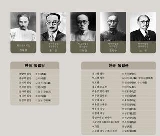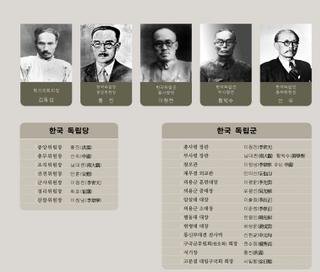
Hong Jin
Encyclopedia
Hong Jin also known as Hong Myeon-hui, was a leader of the Korean independence movement
. He is also sometimes known by his pen name Mano (만오, 晩悟), and his Christian name, Andre.
He was born under the Joseon Dynasty
in Yeongdong
, Chungcheong
Province, to a yangban
family of the Pungsan Hong lineage. He had practiced law in Korea in the private practice and in the government sector as a prosecutor and a judge before joining the independence movement.
Hong held a number of chief positions under the Provisional Government of the Republic of Korea
during the Japanese Occupation
. Under his administration as the fourth President, the provisional Korean government was recognized by the Republic of China
, France and Poland. His main theme was unity among factions of the Korean independence movement
.
In 1928, he established the "Korean Independence Party" (한국독립당, 韓國獨立黨) with Kim Gu
, Yi Dong-nyung
, and he was elected an executive position to the Korean Independence camp (한국광복진선, 韓國光復陣線) in 1938. After Independence of Korea, he returned to South Korea having earned recognition as a Provisional Government leading figure who acted as Chairman of the Emergency national Council (비상국민회의, 非常國民會議). Hong was posthumously honored by the government of the Republic of Korea with the Order of Independence Merit for National Foundation
in 1962.
His biography by Professor Han, Si Joon contains a detailed family tree of Hong Jin tracing back to Goryeo dynasty's Hong Ji-gyeong later known as a great master of Korean classical verse in the Joseon Dynasty
. The current family jokbo contains surviving members of family who are naturalized American citizens.

Korean independence movement
The Korean independence movement grew out of the Japanese colonial rule of the Korean peninsula from 1910 to 1945. After the Japanese surrendered, Korea became independent; that day is now an annual holiday called Gwangbokjeol in South Korea, and Chogukhaebangŭi nal in North Korea.-Background:In...
. He is also sometimes known by his pen name Mano (만오, 晩悟), and his Christian name, Andre.
He was born under the Joseon Dynasty
Joseon Dynasty
Joseon , was a Korean state founded by Taejo Yi Seong-gye that lasted for approximately five centuries. It was founded in the aftermath of the overthrow of the Goryeo at what is today the city of Kaesong. Early on, Korea was retitled and the capital was relocated to modern-day Seoul...
in Yeongdong
Yeongdong
This article is about Yeongdong, a region in eastern Korea. For the county of the same name in North Chungcheong Province, South Korea, see Yeongdong County....
, Chungcheong
Chungcheong
Chungcheong was one of the eight provinces of Korea during the Joseon Dynasty. Chungcheong was located in the southwest of Korea...
Province, to a yangban
Yangban
The yangban were part of the traditional ruling class or nobles of dynastic Korea during the Joseon Dynasty. The yangban were either landed or unlanded aristocracy who comprised the Korean Confucian idea of a "scholarly official." In reality, they were basically administrators and bureaucrats who...
family of the Pungsan Hong lineage. He had practiced law in Korea in the private practice and in the government sector as a prosecutor and a judge before joining the independence movement.
Hong held a number of chief positions under the Provisional Government of the Republic of Korea
Provisional Government of the Republic of Korea
The Provisional Government of the Republic of Korea was the partially recognised government in exile of Korea, based in Shanghai, China, and later in Chongqing, during the Colonial Korea.-History:...
during the Japanese Occupation
Korea under Japanese rule
Korea was under Japanese rule as part of Japan's 35-year imperialist expansion . Japanese rule ended in 1945 shortly after the Japanese defeat in World War II....
. Under his administration as the fourth President, the provisional Korean government was recognized by the Republic of China
Republic of China
The Republic of China , commonly known as Taiwan , is a unitary sovereign state located in East Asia. Originally based in mainland China, the Republic of China currently governs the island of Taiwan , which forms over 99% of its current territory, as well as Penghu, Kinmen, Matsu and other minor...
, France and Poland. His main theme was unity among factions of the Korean independence movement
Korean independence movement
The Korean independence movement grew out of the Japanese colonial rule of the Korean peninsula from 1910 to 1945. After the Japanese surrendered, Korea became independent; that day is now an annual holiday called Gwangbokjeol in South Korea, and Chogukhaebangŭi nal in North Korea.-Background:In...
.
In 1928, he established the "Korean Independence Party" (한국독립당, 韓國獨立黨) with Kim Gu
Kim Gu
Kim Gu , the sixth and later the last president of the Provisional Government of the Republic of Korea, was a Korean politician, educator, leader of Korean independence movement against the Japanese occupation of Korea that lasted from 1910 to 1945, and reunification activist who had struggled for...
, Yi Dong-nyung
Yi Dong-nyung
Yi Dongnyeong was a Korean independence activist. He served as the fourth , seventh , eighth , tenth , and eleventh President of the Provisional Government of the Republic of Korea in exile in Shanghai, China.Yi Dongnyeong, along with Yi Si-yeong,Yi Hoe-young and Yi Sang-ryong, started the Military...
, and he was elected an executive position to the Korean Independence camp (한국광복진선, 韓國光復陣線) in 1938. After Independence of Korea, he returned to South Korea having earned recognition as a Provisional Government leading figure who acted as Chairman of the Emergency national Council (비상국민회의, 非常國民會議). Hong was posthumously honored by the government of the Republic of Korea with the Order of Independence Merit for National Foundation
Order of Merit for National Foundation
The Order of Merit for National Foundation is an Order of South Korea. It is typically reserved for those who contributed to the founding of the modern Republic of Korea.It is awarded in five grades:...
in 1962.
His biography by Professor Han, Si Joon contains a detailed family tree of Hong Jin tracing back to Goryeo dynasty's Hong Ji-gyeong later known as a great master of Korean classical verse in the Joseon Dynasty
Joseon Dynasty
Joseon , was a Korean state founded by Taejo Yi Seong-gye that lasted for approximately five centuries. It was founded in the aftermath of the overthrow of the Goryeo at what is today the city of Kaesong. Early on, Korea was retitled and the capital was relocated to modern-day Seoul...
. The current family jokbo contains surviving members of family who are naturalized American citizens.
Note
- The spelling of his name in his correspondence with American dignitaries including condolence letter regarding President Franklin D. Roosevelt's death was Hong Chin instead of Hong Jin.

See also
- List of Koreans
- History of KoreaHistory of KoreaThe Korean Peninsula was inhabited from the Lower Paleolithic about 400,000-500,000 years ago. Archeological evidence indicates that the presence of modern humans in northeast Asia dates to 39,000 years ago. The earliest known Korean pottery dates to around 8000 BC, and the Neolithic period began...
- Korea under Japanese ruleKorea under Japanese ruleKorea was under Japanese rule as part of Japan's 35-year imperialist expansion . Japanese rule ended in 1945 shortly after the Japanese defeat in World War II....
- Korean independence movements

